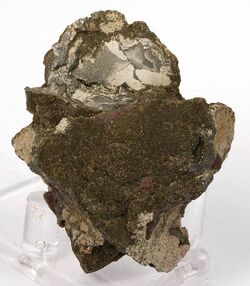Chemistry:Stilpnomelane
From HandWiki
| Stilpnomelane | |
|---|---|
 | |
| General | |
| Category | Phyllosilicates Smectite group |
| Formula (repeating unit) | K(Fe2+,Mg,Fe3+) 8(Si,Al) 12(O,OH) 27 · n(H 2O) |
| Strunz classification | 9.EG.40 |
| Crystal system | Triclinic |
| Crystal class | Pinacoidal (1) (same H-M symbol) |
| Space group | P1 |
| Unit cell | a = 21.72 Å, b = 21.72 Å c = 17.4 Å; α = 124.14° β = 95.86°, γ = 120°; Z = 6 |
| Identification | |
| Color | Black, greenish black, yellowish bronze, greenish bronze |
| Crystal habit | Platey, scaly and fibrous with comb structures; radiating groups |
| Cleavage | Perfect on {001}, imperfect on {010} |
| Tenacity | Brittle |
| Mohs scale hardness | 3–4 |
| |re|er}} | Vitreous to dull |
| Streak | Gray white |
| Diaphaneity | Subtranslucent to opaque |
| Specific gravity | 2.77 – 2.96 |
| Optical properties | Biaxial (−) |
| Refractive index | nα = 1.543 – 1.634 nβ = 1.576 – 1.745 nγ = 1.576 – 1.745 |
| Birefringence | δ = 0.033 – 0.111 |
| Pleochroism | X: bright golden yellow to pale yellow Y and Z: deep reddish brown, to deep green to nearly black |
| 2V angle | 0–40 measured |
| Dispersion | None |
| References | [1][2][3] |
Stilpnomelane is a phyllosilicate mineral. It has the chemical formula K(Fe2+,Mg,Fe3+)
8(Si,Al)
12(O,OH)
27 · n(H
2O).[3]
Stilpnomelane occurs associated with banded iron formations. It is a metamorphic mineral associated with the blueschist and greenschist facies.[1]
It was first described in 1827 for an occurrence in Moravia in the Czech Republic. The name is derived from the Greek stilpnos for shining, and melanos for black.[2]
References
- ↑ 1.0 1.1 Handbook of Mineralogy
- ↑ 2.0 2.1 Stilpnomelane on Mindat
- ↑ 3.0 3.1 Stilpnomelane on Webmineral
- ↑ Warr, L.N. (2021). "IMA–CNMNC approved mineral symbols". Mineralogical Magazine 85 (3): 291–320. doi:10.1180/mgm.2021.43. Bibcode: 2021MinM...85..291W.
 |

